Lieven De Strycker
RF-Powered Batteryless Plant Movement Sensor for Precision Agriculture
Sep 16, 2025Abstract:Precision agriculture demands non-invasive, energy-efficient, and sustainable plant monitoring solutions. In this work, we present the design and implementation of a lightweight, batteryless plant movement sensor powered solely by RF energy. This sensor targets Controlled Environment Agriculture (CEA) and utilizes inertial measurements units (IMUs) to monitor leaf motion, which correlates with plant physiological responses to environmental stress. By eliminating the battery, we reduce the ecological footprint, weight, and maintenance requirements, transitioning from lifetime-based to operation-based energy storage. Our design minimizes circuit complexity while enabling flexible, adaptive readout scheduling based on energy availability and sensor data. We detail the energy requirements, RF power transfer considerations, integration constraints, and outline future directions, including multi-antenna power delivery and networked sensor synchronization.
OWP-IMU: An RSS-based Optical Wireless and IMU Indoor Positioning Dataset
May 22, 2025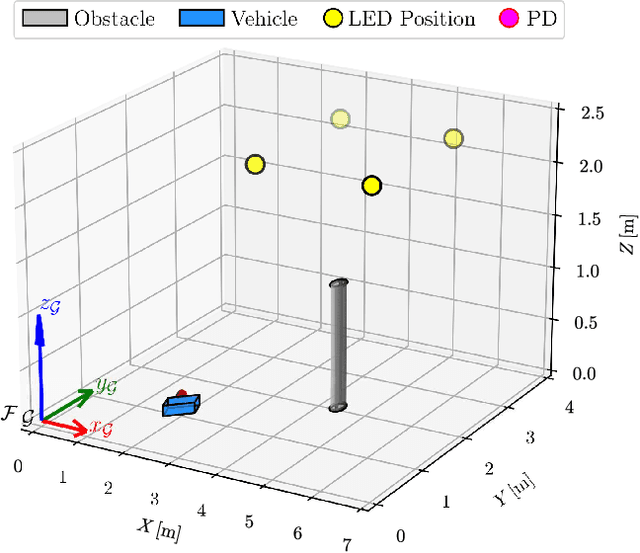
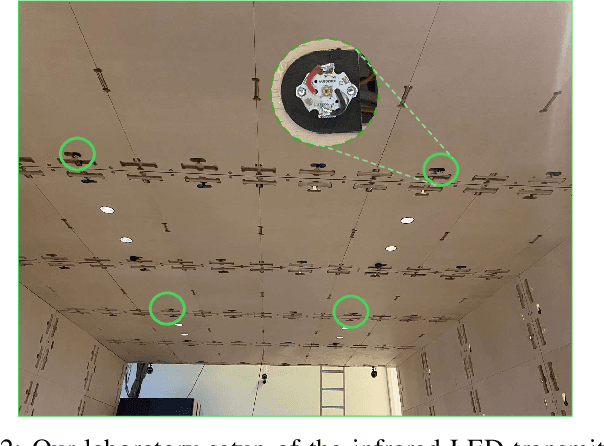
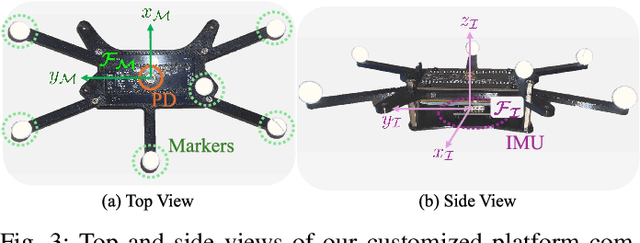
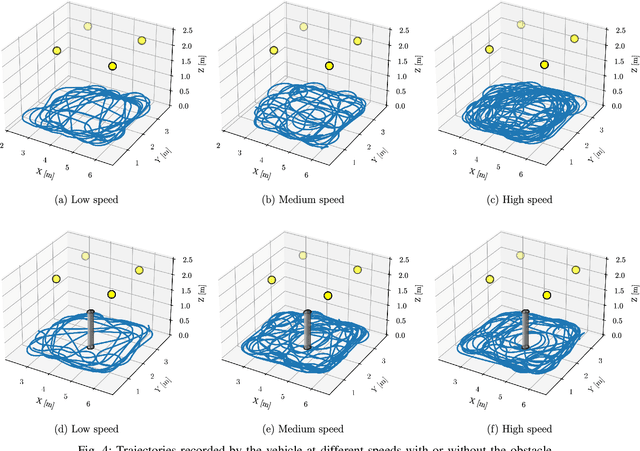
Abstract:Received signal strength (RSS)-based optical wireless positioning (OWP) systems are becoming popular for indoor localization because they are low-cost and accurate. However, few open-source datasets are available to test and analyze RSS-based OWP systems. In this paper, we collected RSS values at a sampling frequency of 27 Hz, inertial measurement unit (IMU) at a sampling frequency of 200 Hz and the ground truth at a sampling frequency of 160 Hz in two indoor environments. One environment has no obstacles, and the other has a metal column as an obstacle to represent a non-line-of-sight (NLOS) scenario. We recorded data with a vehicle at three different speeds (low, medium and high). The dataset includes over 110 k data points and covers more than 80 min. We also provide benchmark tests to show localization performance using only RSS-based OWP and improve accuracy by combining IMU data via extended kalman filter. The dataset OWP-IMU is open source1 to support further research on indoor localization methods.
Experimental Study on the Effect of Synchronization Accuracy for Near-Field RF Wireless Power Transfer in Multi-Antenna Systems
Dec 15, 2024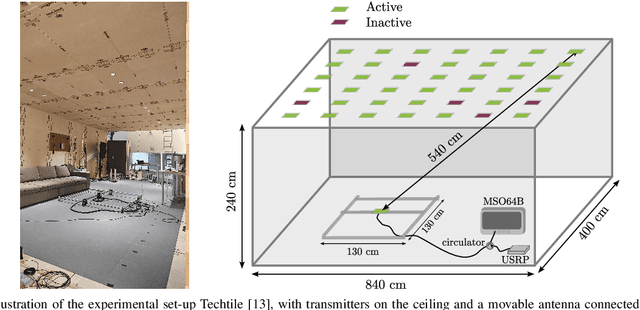
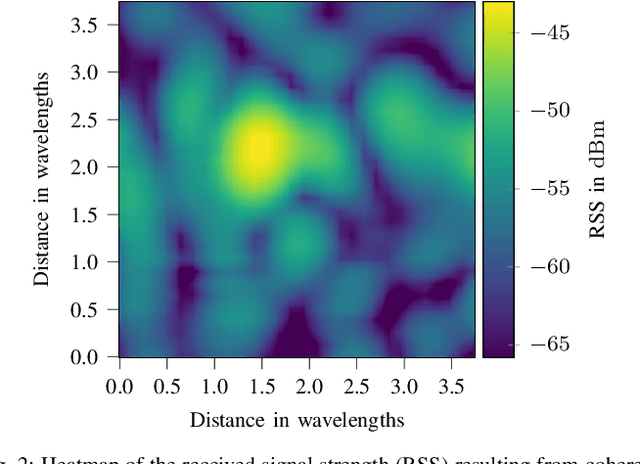
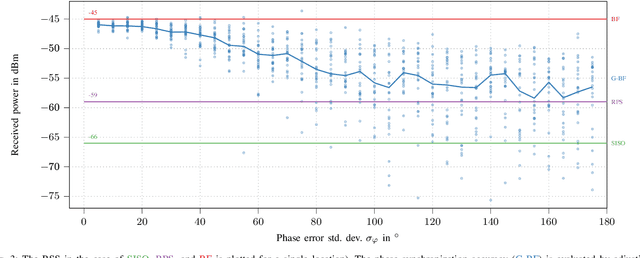

Abstract:Wireless power transfer (WPT) technologies hold promise for enhancing device autonomy, particularly for energy-limited IoT systems. This paper presents experimental results on coherent and non-coherent transmit diversity approaches for WPT, tested in the near field using the Techtile testbed. We demonstrate that a fully synchronized beamfocusing system achieves a 14 dB gain over non-coherent transmission, consistent with the theoretical 14.9 dB gain for a 31-element array. Additionally, phase alignment errors below 20{\deg} result in less than 1 dB of gain loss, while errors exceeding 40{\deg} lead to losses over 3 dB. These findings suggest that phase coherency requirements for WPT can be relaxed, and that scaling the number of antennas is a promising strategy for improving power transfer efficiency.
How to Perform Distributed Precoding to Wirelessly Power Shelf Labels: Signal Processing and Measurements
Aug 20, 2024Abstract:Wireless power transfer (WPT) has garnered increasing attention due to its potential to eliminate device-side batteries. With the advent of (distributed) multiple-input multiple-output (MIMO), radio frequency (RF) WPT has become feasible over extended distances. This study focuses on optimizing the energy delivery to Energy Receivers (ERs) while minimizing system total transmit power. Rather than continuous power delivery, we optimize the precoding weights within specified time slots to meet the energy requirements of the ERs. Both unsynchronized (non-coherent) and synchronized (coherent) systems are evaluated. Our analysis indicates that augmenting the number of antennas and transitioning from an unsynchronized to asynchronized full phase-coherent system substantially enhances system performance. This optimization ensures precise energy delivery, reducing overshoots and overall energy consumption. Experimental validation was conducted using a testbed with84 antennas, validating the trends observed in our numerical simulations.
MmWave for Extended Reality: Open User Mobility Dataset, Characterisation, and Impact on Link Quality
Jul 02, 2024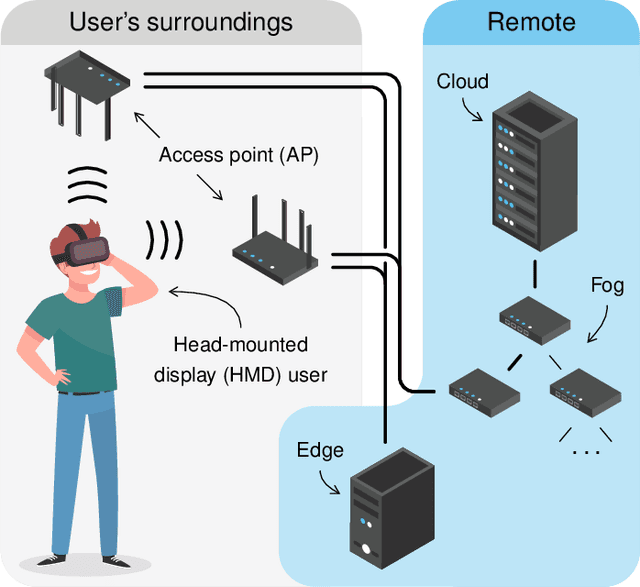
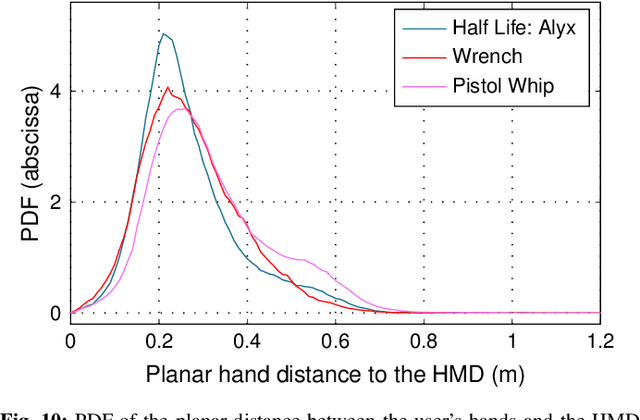
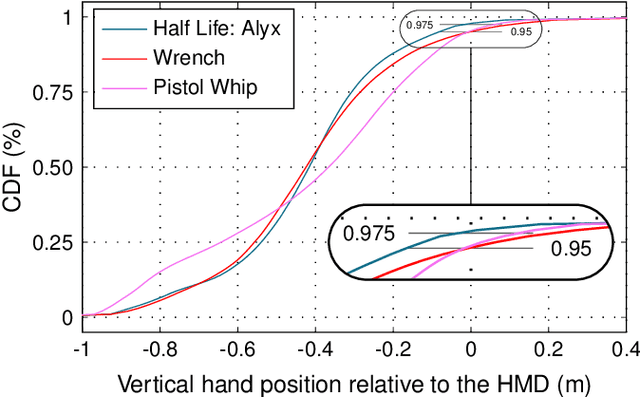
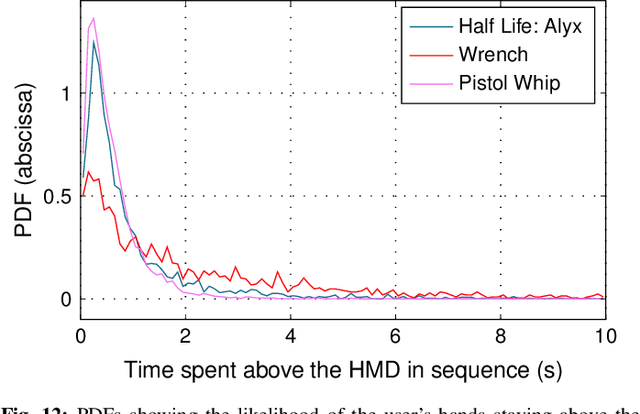
Abstract:User mobility in extended reality (XR) can have a major impact on millimeter-wave (mmWave) links and may require dedicated mitigation strategies to ensure reliable connections and avoid outage. The available prior art has predominantly focused on XR applications with constrained user mobility and limited impact on mmWave channels. We have performed dedicated experiments to extend the characterisation of relevant future XR use cases featuring a high degree of user mobility. To this end, we have carried out a tailor-made measurement campaign and conducted a characterisation of the collected tracking data, including the approximation of the data using statistical distributions. Moreover, we have provided an interpretation of the possible impact of the recorded mobility on mmWave technology. The dataset is made publicly accessible to provide a testing ground for wireless system design and to enable further XR mobility modelling.
Anchor Layout Optimization for Ultrasonic Indoor Positioning Using Swarm Intelligence
May 15, 2024Abstract:Indoor positioning applications are craving for ever higher precision and accuracy across the entire coverage zone. Optimal anchor placement and the deployment of multiple distributed anchor nodes could have a major impact in this regard. This paper examines the influences of these two difficult to approach hypotheses by means of a straightforward ultrasonic 3D indoor positioning system deployed in a real-life scenario via a geometric based simulation framework. To obtain an optimal anchor placement, a particle swarm optimization (PSO) algorithm is introduced and consequently performed for setups ranging from 4 to 10 anchors. In this way, besides the optimal anchor placement layout, the influence of deploying several distributed anchor nodes is investigated. In order to theoretically compare the optimization progress, a system model and Cram\'er-Rao lower bound (CRLB) are established and the results are quantified based on the simulation data. With limited anchors, the placement is crucial to obtain a high precision high reliability (HPHR) indoor positioning system (IPS), while the addition of anchors, to a lesser extent, gives a supplementary improvement.
Channel Performance Metrics and Evaluation for XR Head-Mounted Displays with mmWave Arrays
Apr 30, 2024Abstract:Millimeter-wave (mmWave) technology holds the potential to revolutionize head-mounted displays (HMDs) by enabling high-speed wireless communication with nearby processing nodes, where complex video rendering can take place. However, the sparse angular profile of mmWave channels, coupled with the narrow field of view (FoV) of patch-antenna arrays and frequent HMD rotation, can lead to poor performance. We introduce six channel performance metrics to evaluate the performance of an HMD equipped with mmWave arrays. We analyze the metrics using analytical models, discuss their impact for the application, and apply them to 28 GHz channel sounding data, collected in a conference room using eight HMD patch-antenna arrays, offset by 45 degrees from each other in azimuth. Our findings confirm that a single array performs poorly due to the narrow FoV, and featuring multiple arrays along the HMD's azimuth is required. Namely, the broader FoV stabilizes channel gain during HMD rotation, lessens the attenuation caused by line of sight (LoS) obstruction, and increases the channel's spatial multiplexing capability. In light of our findings, we conclude that it is imperative to either equip the HMD with multiple arrays or, as an alternative approach, incorporate macroscopic diversity by leveraging distributed access point (AP) infrastructure.
Enhancing RSS-Based Visible Light Positioning by Optimal Calibrating the LED Tilt and Gain
Apr 29, 2024
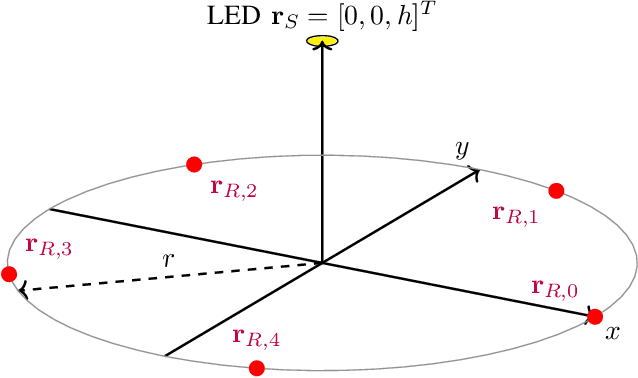
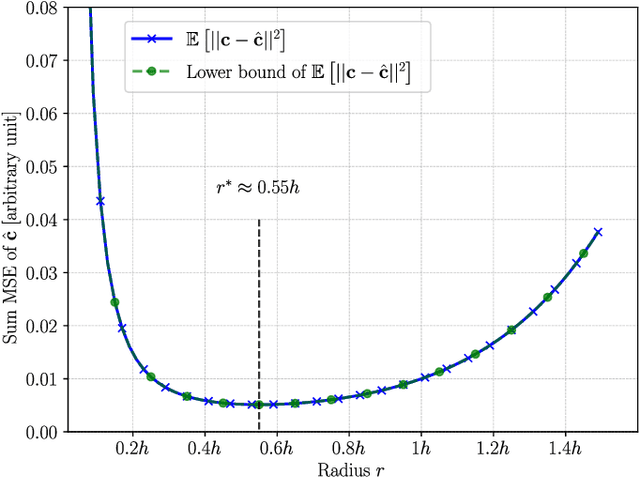

Abstract:This paper presents an optimal calibration scheme and a weighted least squares (LS) localization algorithm for received signal strength (RSS) based visible light positioning (VLP) systems, focusing on the often overlooked impact of light emitting diode (LED) tilt. By optimally calibrating LED tilt and gain, we significantly enhance VLP localization accuracy. Our algorithm outperforms both machine learning Gaussian processes (GPs) and traditional multilateration techniques. Against GPs, it achieves improvements of 58% and 74% in the 50th and 99th percentiles, respectively. When compared to multilateration, it reduces the 50th percentile error from 7.4 cm to 3.2 cm and the 99th percentile error from 25.7 cm to 11 cm. We introduce a low-complexity estimator for tilt and gain that meets the Cramer-Rao lower bound (CRLB) for the mean squared error (MSE), emphasizing its precision and efficiency. Further, we elaborate on optimal calibration measurement placement and refine the observation model to include residual calibration errors, thereby improving localization performance. The weighted LS algorithm's effectiveness is validated through simulations and real-world data, consistently outperforming GPs and multilateration, across various training set sizes and reducing outlier errors. Our findings underscore the critical role of LED tilt calibration in advancing VLP system accuracy and contribute to a more precise model for indoor positioning technologies.
Impact of Array Configuration on Head-Mounted Display Performance at mmWave Bands
Dec 12, 2023



Abstract:Immersing a user in life-like extended reality (XR) scenery using a head-mounted display (HMD) with a constrained form factor and hardware complexity requires remote rendering on a nearby edge server or computer. Millimeter-wave (mmWave) communication technology can provide sufficient data rate for wireless XR content transmission. However, mmWave channels exhibit severe sparsity in the angular domain. This means that distributed antenna arrays are required to cover a larger angular area and to combat outage during HMD rotation. At the same time, one would prefer fewer antenna elements/arrays for a lower complexity system. Therefore, it is important to evaluate the trade-off between the number of antenna arrays and the achievable performance to find a proper practical solution. This work presents indoor 28 GHz mmWave channel measurement data, collected during HMD mobility, and studies the dominant eigenmode (DE) gain. DE gain is a significant factor in understanding system performance since mmWave channel sparsity and eigenmode imbalance often results in provisioning the majority of the available power to the DE. Moreover, it provides the upper performance bounds for widely-adopted analog beamformers. We propose 3 performance metrics - gain trade-off, gain volatility, and minimum service trade-off - for evaluating the performance of a multi-array HMD and apply the metrics to indoor 28 GHz channel measurement data. Evaluation results indicate, that 3 arrays provide stable temporal channel gain. Adding a 4th array further increases channel capacity, while any additional arrays do not significantly increase physical layer performance.
An Acoustic Simulation Framework to Support Indoor Positioning and Data Driven Signal Processing Assessments
May 04, 2023Abstract:We present an indoor acoustic simulation framework that supports both ultrasonic and audible signaling. The framework opens the opportunity for fast indoor acoustic data generation and positioning development. The improved Pyroomacoustics-based physical model includes both an image-source model (ISM) and ray tracing method to simulate acoustic signaling in geometric spaces that extend typical shoe-box rooms. Moreover, it offers the convenience to facilitate multiple speakers and microphones with different directivity patterns. In addition to temperature and air absorption, the room reverberation is taken into account characterized by the RT60 value or the combination of building materials. Additional noise sources can be added by means of post processing and/or extra speakers. Indoor positioning methods assessed in simulation are compared with real measurements in a testbed, called 'Techtile'. This analysis confirms that the simulation results are close to the measurements and form a realistic representation of the reality. The simulation framework is constructed in a modular way, and parts can be replaced or modified to support different application domains. The code is made available open source.
 Add to Chrome
Add to Chrome Add to Firefox
Add to Firefox Add to Edge
Add to Edge